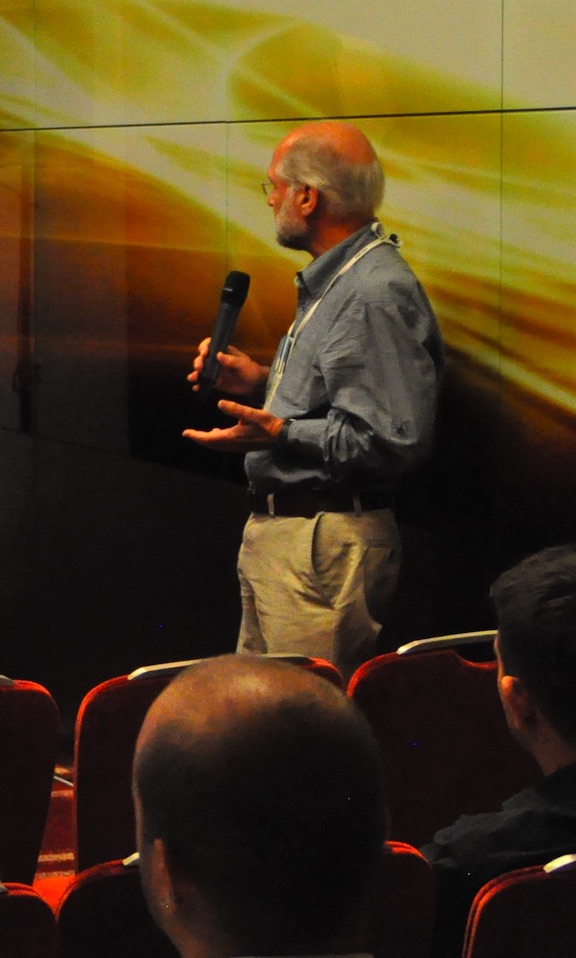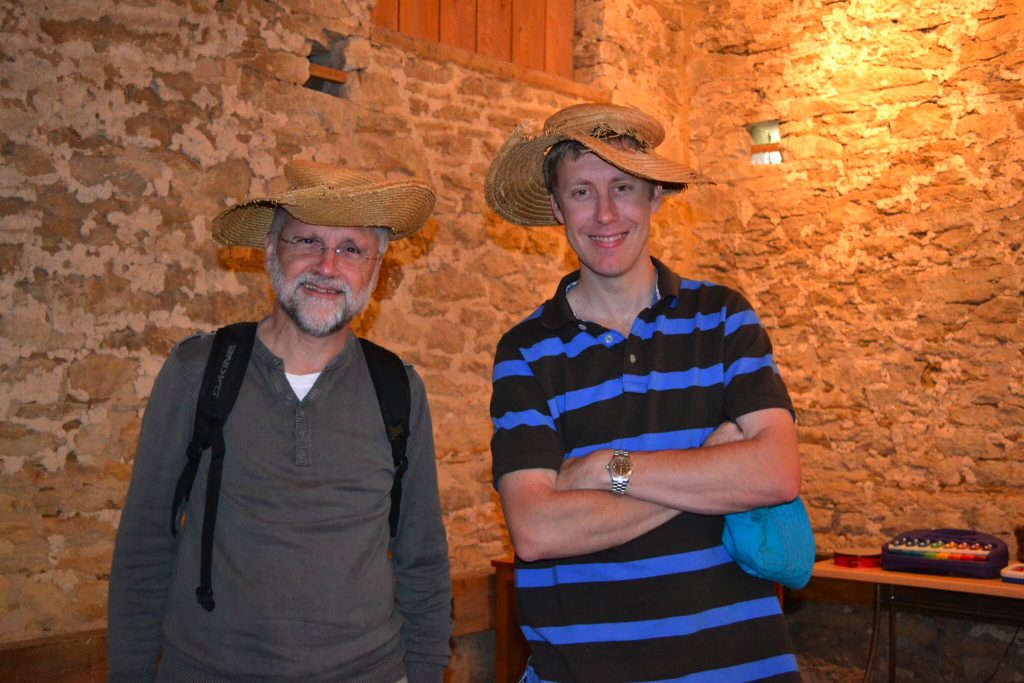Introduction
We see this Special Issue, dedicated to the memory of Dr. Nigel Bevan, as having four purposes. One is that it will provide a lasting legacy for Nigel as an outstanding scientist and one of the kindest, most humane human beings either of us have ever met. He was the most thorough scientist one could imagine: certain of the direction in which he thought HCI should evolve, but always willing to listen to other viewpoints. In fact, he did not only listen—he took other opinions as seriously as his own, always willing to consider the merit of such alternatives. He was well known for refusing to give up until a standard was just right. While we recognize that extreme meticulousness is a painful—yet absolutely essential—ingredient in standards work, we also note that precise and tenacious people can be fun, generous, kind, and very approachable. Nigel was all of those.
The second purpose of this Special Issue is to document Nigel’s tireless contribution to the development, refinement, and evolution of HCI/usability/UX-related national and international standards. The long list of standards to which he so generously contributed, the many standards he edited, and the standards committees he chaired over nearly 40 years testify to a super-human dedication, perseverance, and unwavering attention to detail. Lengthy committee meetings are, as we all know, very tiring for standards committee members, but because he was the kindest of people, there was never a sign of aggression or disharmony in those committees.
We have attempted to assemble that impressive list of standards
in which he was closely involved; it is presented at the end of this article in
Appendix A. In the discussion of standards, we also reflect upon their history
and evolution as well as commenting on the currently existing
usability/UX-related standards and the role these play, or ought to play, in
the HCI profession. In addition to the list of standards, Nigel’s family shares
a selection of photos, in Appendix B, that illustrate his life and adventures.
The number of UX practitioners has grown exponentially since the early 1980s, and it is likely that many, especially newcomers to the profession, might not know the state of UX in those early days or how far the profession has come since then. Accordingly, our third purpose is to publicly acknowledge the profound impact of Nigel’s work on usability and hence on the usability/UX community. In an overview of the development of the discipline, we demonstrate how his meticulous efforts in the usability/UX arena have benefited HCI communities throughout the world.
The fourth and final purpose of this Special Issue is to draw attention to Nigel, the nature-lover, the hiker, and fresh-air enthusiast. As several of the contributors to this Special Issue point out, Nigel would always find a way to get out in the open before, during, and after a conference or a meeting, and whoever wanted to join him was typically invited and welcomed with open arms.
Invited Contributions
We invited a small group of Nigel’s important and close colleagues, namely Tom Stewart, Jonathan Earthy, and Daryle Gardner-Bonneau, to share their perceptions, views, and experiences as active contributors to the dominant international usability standards. Tom Stewart has known Nigel since the early 1980s at the UK’s National Physical Laboratory. Tom confesses to a passionate belief, shared with Nigel, in the importance of standards, especially international standards, that serve to improve the design of user interfaces. Tom was the chairperson of what was the very first ISO subcommittee focusing on human-system interaction. A sign of those times, the task of that subcommittee was to address a range of issues associated with “visual information processing.” Tom reports how the main concern was with the potential negative effects on users of working with what were then called visual display terminals (VDTs). Given that that initial work was informed predominantly by the discipline of ergonomics, Tom recalls, a lot of effort naturally went into investigating the design of hardware such as keyboards, workstations, and the like.
Research into the human cognitive aspects of human-computer interaction was also only beginning to be recognized, notably with the publication of Card, Moran, and Newell’s book The Psychology of Human-Computer Interaction in 1983 and the founding of the specialist HCI group in the British Computer Society in 1984 and the founding of the ACM SIGCHI a little earlier. Only later did the importance of software design take center stage in the standards arena, culminating in, probably the best known and most influential standard, ISO 9241:11 in 1998, of which Nigel was the project editor and Tom was again a contributor.
Jonathan Earthy’s contribution brings a slightly different perspective. Although coming from the viewpoint of the originally British national standards perspective, Jonathan has also contributed to the development of international ergonomics standards since the 1980s. He is thus currently serving as the convenor of the international Work Group ISO/TC159/SC1/WWG6, Human-centred design for interactive systems. His job in assurance requires him to coordinate human factors assessments, that is, understanding how best to assure that the necessary rigor has been invested in ergonomics and human-centered design efforts so as to avoid or, at least, reduce the risk of human-system hazards including usability issues.
Complementing the focus on the interaction of individuals with computers in their daily work settings, more recent standards work now involves considerations of much larger time- and safety-critical systems, the lifecycle of which is also considerably longer than that of consumer products. That work is approached from a human-factors engineering perspective with a focus on the maintenance, repair, disposal, and retirement of these. This work, on the ISO 9241 – 220, is discussed in the paper by Daryle Gardner-Bonneau. Daryle goes on to describe some of the work of the ISO/TC159/SC1/WWG5 on which she serves as the convenor. Its work, which has already led to a standard on the human-centered organization, is clarifying how ergonomics impacts whole organizations. These contributions all bear witness to Nigel’s work in the standards arena and impact on definitions of usability. This work was continued in the current revision of the standard ISO 9241 and its constituent parts, in which Nigel’s involvement was crucial to the development of the “Ergonomics of human system interaction – Human-centred design and evaluation methods.” This important contribution displays his commitment to good—and effective—design and to the standards-based development of usable evaluation techniques, both in initial design stages and in the development and implementation of interactive systems.
Nigel’s overriding contributions to usability/UX, concern for users’ roles in product development, their well-being, and indeed the entire quality of human-product interaction invariably take center stage. The impact of Nigel’s work in that area is shown very clearly in both Chris Hass’ and Tom Tullis’ articles in this issue. Tullis demonstrates Nigel’s impact on the usability/UX community through his lengthy involvement with the UPA/UXPA—not least his efforts in establishing the World Usability Day, now a world-wide celebration happening annually. As the UXPA Director of Professional Development, Nigel continued nurturing usability through the creation of the Usability Body of Knowledge initiative. Another very important document is the Common Industry Format (CIF), briefly discussed in the article by Chris Hass. The CIF supports usability professionals by describing a very systematic method for reporting quantitative findings from usability tests. It also aims to support stakeholders who must decide if a software product is ready for release or which software tools their organization should purchase. The CIF became an ANSI standard (ANSI/NCITS 345-2001) in 2001 and an ISO standard (ISO/IEC 25062:2006) in 2006 (Hodgson, 2018). Chris describes how its rigor and the clarity with which it conveys complex information, has helped him to, as he says, “do it right” since his early days as a UX professional. Admitting that it was very hard to implement the methods at first, he still appreciates it for its utmost attention to detail, which, all contributors to this issue seem to agree on, was one of Nigel’s most important strengths pervading all his contributions to standards, including to the CIF.
As another contributor to the CIF, Tullis traces the history of Nigel’s work on defining usability dating back to the “pre-usability” era in the early 1980s at which time the focus was on human factors and ergonomics as mentioned earlier. Via quotes borrowed from some of Nigel’s papers, Tullis takes us through the morphing of usability into the concept of “quality of use” in the mid-1990s to the term “Quality in Use for All” in 1999, leading to the recognition of “user experience” in a paper co-authored with Helen Petrie in 2009. Finally, he discusses the work on the Usability Body of Knowledge (BoK), a great resource for everyone with an interest in, or active involvement with, usability, giving credit to Nigel’s role as the Managing Editor as one of the driving forces behind it.
Much of Masaaki Kurosu’s discussion centers on his concern for the qualitative aspects of usability as captured in the concept of user “satisfaction” in the context of UX. Whereas effectiveness and efficiency are both readily quantifiable and thus measurable, satisfaction is much less tangible and therefore harder to define. Masaaki asserts that Nigel might have been dissatisfied with the early definition of satisfaction as an indication of comfort, which seems to have sparked an intense, but respectfully friendly, ongoing discussion between the two researchers. They continued that discussion right up until Nigel’s death last year. Masaaki discusses a model that he developed over several years that emphasizes the relationship of satisfaction to UX.
In a deeply human contribution, Zhengjie Liu illustrates very clearly Nigel’s profound impact on the development of usability and UX in China from the late 1990s. He describes how, by creating the first usability center in China, the Sino-European Usability Center, Nigel facilitated the successful introduction of usability engineering practices into Chinese industry. In typical Nigel-fashion, he freely shared materials and ideas for how to manage that introduction. Zhengjie’s subsequent involvement in UsabilityNet inspired interest that brought the counsellor for science and technology of the EU Delegation in China to Dalian for a personal visit with Zhengjie and his colleagues, eventually culminating in a project funded by the China-EU Science and Technology Cooperation Program of the Ministry of Science and Technology of China. For us in the Western part of the world, it can be hard to understand just how difficult it is to spearhead what amounts to a cultural change in a country with such traditional values as in China; Zhengjie’s paper provides a glimpse of exactly that.
Life and Career
Nigel Bevan was born on the 18th of July in 1946, in Essex, UK but lived in London for most of his life. He died suddenly and unexpectedly in Mulu National Park in Sarawak, Malaysia on the 26th of March 2018. He fell, injuring his head while scaling the Pinnacles with a small group and died suddenly soon afterwards. He leaves behind a wife, Anne, two adult children, Nikki and David, and three grandchildren.
Nigel obtained two first academic degrees: one in Physics from Imperial College, London and a later degree in Psychology from Birkbeck College, University of London. He carried out his PhD work in Man-Machine Interaction, specifically on keyboard and keypad layouts under the direction of Professor Brian Shackel at Loughborough University. This was the work of which he was most proud, impacting on the design of keypad layouts in use today.
He joined the National Physical Laboratory (NPL, the UK’s National Measurement Institute) in Teddington in 1973 and remained there for 25 years, first as a member of, then as Head of the HCI Group in the Division of Information Technology and Computing (DITC). He worked initially with Dr. Chris Evans on physical interfaces for the disabled and then on the doctor-patient medical interviewing application called MICKIE (which was an exhibit in the UK Science Museum during the 1980s). An initiative in authoring systems came next with the development of a successful software package entitled MICROTEXT using the then novel technology of videodiscs. At that time, he was also member of BLEND, a pioneering electronic messaging and online journal initiated by Professor Shackel for the British Library. He later became a Research Associate at the University of York and, as a result of his position as a Scientific Civil Servant, held a post in the 1980s for a year as an assistant to the UK Chief Scientist.
Nigel was Head of the Usability Section at NPL for a number of years, also managing Alvey and European Commission Framework Programme funded projects. He was technical co-coordinator of the Measurement of Usability in Context (MUSiC) project that produced commercial methods for usability measurement. He was Project Manager of the INUSE and RESPECT projects that set up a network of Usability Support Centres around Europe. The TRUMP project that he was involved in incorporated user centered design aspects into the development processes of two large organizations, and another project he was involved in—the PRUE project—trialled the use of the CIF for usability test reports. The influential UsabilityNet project established a comprehensive website of usability resources which, sadly, is no longer available.
He then went on to become Research Manager at Serco Usability Services, an NPL spinoff company, until the early 2000s before becoming a successful professional Usability Consultant some 15 years or so ago, carrying out work for several prominent institutions.
Professional Life
Nigel was a member of the TC13 (on Human-Machine Interaction) committee of the International Federation of Information Processing societies (IFIP) and was instrumental in the creation of the first of the ongoing INTERACT conferences in 1984. He remained heavily involved in TC13 and in INTERACT activities for many years after its formation in 1989.
He was a founding member of the British HCI Group under the aegis of the British Computer Society (BCS HCI SG) and was its first Chair. He was a Fellow of the BCS and the British Psychology Society, and an active member of the Association for Computing Machines Special Interest Group on Computer-Human Interaction (ACM SIGCHI) and the User Experience Professionals Association International (UXPA).
He worked with the US National Academies Committee on Human-System Design Support and was a contributor to the Dagstuhl Workshop, “Demarcating User Experience,” the discussion there being summarized as an influential UX White Paper in 2011. In the 1990s the Usability Forum with which he was involved made a significant difference in industrial engagement for the practice of usability.
His commitment and extensive involvement with UXPA was acknowledged by being presented with both the UXPA “President’s Award” and, posthumously, the UXPA “Lifetime Achievement Award.”
Nigel Bevan’s Contribution to the Evolution of Usability Standards
The International Organization for Standardization (ISO) is an independent, international, and non-governmental organization comprising some 164 national standards bodies. Its rationale is to “…bring together experts to share knowledge and develop voluntary, consensus-based, market relevant International Standards that support innovation and provide solutions to global challenges” (ISO, n.d.). ISO sometimes works in conjunction with the International Electrotechnical Commission (IEC) to create joint standards. ISO itself covers many industries including that of technology and, especially pertinent here, this community of UX and Usability professionals. It provides and manages standards that impact on businesses to “ensure that products and services are safe, reliable and of good quality.” ISO standards are developed through consensus between international domain experts who bring with them a wide range of relevant knowledge and experience. Such global standards assist companies as strategic tools in various ways: by facilitating access to new markets based on free and fair global trade, by reducing costs through minimizing waste and errors to help increase productivity, and by the application of standards to the fostering of governmental policy and regulation.
Benefits of Standards for Usability
A representative to ISO as a senior scientist at NPL, Nigel Bevan was in an excellent position to push for a move to standardization of elements of human-computer interaction during the 1980s. The first, and most widely known, ISO standard mentioning the term usability was the ISO 9241:11 (1998), called “Ergonomic requirements for office work with visual display terminals (VDTs): Guidance on usability.” Note how the term usability seemed almost to represent an afterthought, like a poor second cousin, to the main consideration of ergonomics. Confusion was still rife about what usability is, what concepts are, or should be, subsumed under it, how to achieve high levels of it, and who was/was not qualified to call themselves a usability expert. The term satisfaction, the least well-defined of the original terms subsuming the original concept of usability, was first translated into a vague notion of comfort, still tied closely to supporting human work. Gradually, it became clear that the usability concept involves things other than aiming to make people more effective, efficient, and “comfortable” at work, so usability became user-centered, and eventually human-centered. The term human-centered encompasses concepts such as emotion, aesthetics, and many others that are much harder to define and that cannot be measured via human performance. In order to provide the widest scope, human-centered standards apply to both the specification of usable consumer products and to the vendors of these who should be able to design, develop, test, and finally release such systems and products.
On the one hand, standards are important for guiding usability practitioners, helping them to consider all aspects necessary to accomplish the desired levels of product usability. On the other hand, they create real difficulties because there is so much more to consider, to do, and to think about than is immediately obvious to the neophyte usability expert. Perhaps most importantly, dogged adherence to the right standards silences those people, often senior managers responsible for keeping projects on track, time- and money-wise, who might otherwise argue that usability is merely the final gloss that can safely be ignored if a project runs behind schedule. These days, most large ICT companies tend to adhere to the ISO 9000 series on quality management, so they know about the rigor of standards, and they know that their customers demand adherence to these. Without usability standards, it is merely your opinion against someone else’s.
Now, in addition to standards giving you a voice, to quote from an overview of the standards for usability, Earthy, Sherwood-Jones, and Bevan (2012) say that
…standards play an important role in improving the usability of systems:
- They offer the possibility of consistency, even at an international level.
- They provide a disciplined framework for human factors recommendations and make them accessible to non-specialist.
- They represent consensus about good practice. (p. 267)
Some Standards for Usability
In a previous paper for this journal, Nigel discussed some of the purposes of using standards in general as being “…to impose consistency, compatibility, and safety” and those of standards for usability (most especially that of the ISO 9241 series) as being “a very good primer for good practice in user interface design” providing “authoritative evidence” (Bevan, 2009) and a mechanism for evaluating interface solutions against the guideline.
The original ISO standard, ably described in the contribution by Tom Stewart, was subsequently revised in ISO 9241:11: 1998 (Ergonomics of human-system interaction: Usability Definitions and Concepts) with Nigel as an advocate. The definition created the well-known description of usability in terms of effectiveness, efficiency, and satisfaction and brings into play the concept of context. The full definition, championed by Nigel, is, “The extent to which a product can be used by specified users to achieve specified goals with efficiency, effectiveness and satisfaction in a specified context of use” (Bevan, 2009, p. 108). Context is introduced as, “A context-of-use description includes information about the users and other stakeholder groups, the characteristics of each user group, the goals of the users, the tasks of the users, and the environment(s) in which the system is used” (ISO/IEC, 2014). This aspect and the related ISO 9241 Part 210 standard (Ergonomics of human-system interaction — Part 210: Human-centred design for interactive systems) brings the focus of attention to the impact and influence of this important standard as documented by several of the invited contributions to this issue.
This standard was updated in 2018 to include more reference and coherence to human-centered design and to its importance for organizations as well as developers and UX professionals. Constituent parts of ISO 9241 (see Appendix A) cover human-centered design principles and deliver a framework for understanding what usability is as a concept, placing these as central to the overall design life-cycle of computer artifacts and systems.
In the TC159 SC1/WG5 committee, another revision, which is now ISO 27501 (The human-centred organization: Guidance for managers), was approved shortly after Nigel’s death. This provides requirements and recommendations on the human factors and ergonomics approach to achieving a successful and sustainable human-centered organization. By outlining the responsibilities of managers at any level, it helps an organization to develop and implement procedures and processes enabling human centeredness. As has been described by Daryle Gardner-Bonneau, such requirements and recommendations can be applied in order to fulfil the seven principles of human-centered organizations outlined in ISO 27500.
Members of TC159 SC4/WG6, when Nigel was Project Leader or Editor, had been developing an updated approach to human-centered design as it specifically applies to organizations, with an emphasis on design and evaluation methods, extending the remit of current UX and HCI standards. Of the two standards involved, ISO 9241-220 (Ergonomics of human-system interaction – Processes for enabling, executing and assessing human-centred design within organizations) and ISO 9241-230 (Ergonomics of human system interaction – Human-centred design and evaluation methods), the former was published and the latter was abandoned due to lack of a replacement editor. These standards (and the many others that Nigel worked on) are a testament to his valuable input and will leave a timely and highly suitable memorial to his life’s work.
A Legacy
Through his long-term commitment, he was an untiring advocate for very specific definitions in order to achieve the overall aims of the standardization process. He championed extensive individual standards and carefully honed the quantifiable definitions of usability and its components to describe, evaluate, and support the process of designing user interfaces. This is his impressive legacy, which will continue to influence both the HCI and UX disciplines. We have added two appendices to this article: Appendix A attempts to list the many ISO standards with which Nigel was involved in (but which may still be incomplete), and Appendix B shares some personal photos of Nigel’s life.
A Personal Appreciation
Nigel Bevan was knowledgeable, a good conversationalist, always interested in talking with colleagues (old and new) about exciting challenges. He was fascinated by people but also loved good food and wine, seeing new sights, discovering new cultures, and trying out new gadgets. His passion, in addition to his work, was in hiking, walking, and climbing, usually in challenging circumstances. He travelled widely across the globe for his work and always added some adventurous expedition on his visits to faraway places.
To those of us who knew Nigel personally, or those who were closely involved with him, his loss is a deeply-felt one and his contribution to our discipline is exceptionally difficult to replicate. He will be missed by many, as the number of personal reminiscences on his memorial site and the articles we present here so clearly show.
We have both benefited from his untiring presence and encouragement in our careers in HCI: Dianne Murray as a work colleague of more than 12 years at NPL and as a Founding Editor of the BCS HCI Group’s journal Interacting with Computers, and Gitte Lindgaard as a long-term fellow member of IFIP’s TC13 Committee and Deputy Editor of that journal for many years.
Acknowledgements
We would like to thank all the contributors to this memorial for their memories of Nigel and for their insights into his work, which they have gracefully shared with us. Thanks are also due to the Editors of the journal for their assistance and for allowing us the chance to provide a lasting memorial to someone who is sadly missed.
References
Bevan, N. (2009). International standards for usability should be more widely used. Journal of Usability Studies, 4(3), 106–113.
Card. S., Moran, T., & Newell, A. (1983). The psychology of human-computer interaction. Hillsdale, NJ, USA: Lawrence Erlbaum Associates, Inc.
Earthy, J., Sherwood Jones, B., & Bevan, N. (2012). ISO standards for user-centered design and the specification of usability. In E. Buie & D. Murray, (Eds.), Usability in government systems: User experience design for citizens and public servants (1st ed.). San Francisco, CA, USA: Morgan Kaufmann Publishers Inc.
Hodgson, P. (2018). Measuring usability with the Common Industry Format (CIF). Userfocus. Retrieved from March 2019 https://www.userfocus.co.uk/articles/picnic.html.
International Organization for Standardization (ISO). (n.d.). All about ISO page. Retrieved February 2019 from https://www.iso.org/about-us.html. International Organization for Standardization/International Electrotechnical Commission (ISO/IEC). (2014). Systems and software engineering — Systems and software product Quality Requirements and Evaluation (SQuaRE) — Common Industry Format (CIF) for usability: Context of use description. (ISO/IEC Standard No. 25063:2014). Retrieved April 2019 from https://webstore.iec.ch/publication/11256.
Appendix A
The following table shows Nigel Bevan’s ISO and IEC standards involvement.
|
Standard |
Title |
Committee |
Role |
Pub date |
Type |
Comments |
|
ISO 9241-11 |
Ergonomic requirements for office work with visual display terminals (VDTs): Guidance on usability |
TC159/SC4 |
Editor |
1998 |
Erg. |
Early HCI related standards on human-system interaction. Now superseded. |
|
ISO/IEC JTC1/SC35 |
User interfaces |
ISO/IEC JTC1/SC35 |
Member |
1998 |
SSE |
IT Tools that help support the standards development process. |
|
ISO 9241 – 11 |
Ergonomics of human-system interaction: Usability Definitions and Concepts |
TC159 SC4 |
Editor |
1998 |
Erg. |
Influential in definition of usability. |
|
ISO/IEC 14598-1 |
Information Technology: Software product evaluation – Part 1: General overview |
ISO/IEC JTC1/SC7/ WG6 |
Member |
1999 |
SSE |
Now superseded by ISO/IEC 25040:2011 Systems and software engineering — Systems and software Quality Requirements and Evaluation (SQuaRE) — Evaluation process. |
|
ISO 13407 |
Human-centred design processes for interactive systems |
TC159/SC4/WG6 |
Member |
1999 |
Erg. |
Now revised as ISO 9241-210:2010. Ergonomics of human-system interaction — Part 210: Human-centred design for interactive systems. |
|
ISO 9126-1 |
Software engineering – Product quality – Part 1: Quality model |
ISO/IEC JTCI/SC7/ WG6 |
Member |
2001 |
SSE |
Processes, supporting tools and supporting technologies for the engineering of software products and systems. Now withdrawn. |
|
ISO 9126-4 |
Software engineering – Product quality – Part 4: Quality in use metrics |
ISO/IEC JTCI/SC7/ WG6 |
Member |
2004 |
SSE |
Quality in use metrics to measure the effects of using software in a specific context of use. Revised as ISO/IEC 25022:2016. |
|
ISO/IEC 25062 |
Software engineering – Software product Quality Requirements and Evaluation (SQuaRE) Common Industry Format (CIF) for usability test reports |
ISO/IEC JTC1/SC7/ WG6 |
Member |
2006 |
SSE |
Provides a standard method for reporting results of formal usability tests when quantitative measurements were collected. Appropriate for summative / comparative testing. |
|
ISO SC7 20282-1 |
Ease of operation of everyday products – Part 1: Design requirements for context of use and user characteristics |
TC159 SC4 |
Convenor |
2006 |
Erg. |
Design requirements for the usability of everyday things. |
|
ISO 9241-210 |
Ergonomics of human-system interaction – Part 210: Human-centred design for interactive systems |
ISO/IEC JTCI/SC7/ WG6 |
Member |
2010 |
Erg. |
Provides requirements and recommendations for human-centered design principles and activities throughout the life cycle of computer-based interactive systems. |
|
IEC 62508 |
Guidance on human aspects of dependability |
TC56 |
Member |
2010 |
SSE |
Guidance for dependability including ergonomic principles during design and human reliability understanding. |
|
ISO /IEC 25010 |
Systems and software engineering – Systems and software Quality Requirements and Evaluation (SQuaRE) — System and software quality models |
ISO/IEC JTC1/SC7/ WG6 |
Editor (elected Project Leader for revision) |
2011 |
SSE |
Definition of quality in use and product quality models applicable to the human-computer system, computer systems and software products. |
|
ISO/TS 20282-2 |
Usability of consumer products and products for public use — Summative test method |
TC159 SC4 |
Editor |
2013 |
Erg. |
Specifies a user-based summative test method for the measurement of the usability and/or accessibility of consumer products. |
|
ISO/IEC 25063 |
Systems and software engineering – Systems and software product Quality Requirements and Evaluation (SQuaRE) – Common Industry Format (CIF) for usability: Context of use description |
ISO/IEC JTC1/SC7/ WG6 |
Project Leader |
2014 |
SSE |
Describes the Common Industry Format (CIF) for context of use descriptions and specifies the contents of both high-level and detailed descriptions for systems. |
|
ISO 25022 |
Systems and software engineering – Systems and software product quality requirements and evaluation (SQuaRE) – Measurement of quality in use |
ISO/IEC JTC1/SC7/ WG6 |
Project Leader |
2016 |
SSE |
Defines quality in use measures for the characteristics defined in ISO/IEC 25010. |
|
ISO 27500 |
The human-centred organization – Rationale and general principles |
TC159 SC1/WG5 |
Member |
2016 |
Erg. |
Intended for executive board members and policy makers of organizations, and it describes the values and beliefs that make an organization human-centered. |
|
ISO 9241-11 |
Ergonomics of human-system interaction – Usability: Definitions and concepts |
TC159 SC4/WG6 |
Project Leader |
2018 |
Erg. |
A recently updated version of the earlier standard. Usability as an outcome of use. Defines key terms and concepts and identifies the fundamentals of usability, explaining its applicability. |
|
ISO 27501 |
The human-centred organization: Guidance for managers |
TC159 SC1/WG5 |
Member |
2019 |
Erg. |
Provides requirements and recommendations for managers and the actions to be taken in order for an organization to achieve human centeredness. |
|
ISO 9241-220 |
Ergonomics of human–system interaction — Processes for enabling, executing and assessing human-centred design within organizations |
TC159 SC4/WG6 |
Editor |
2019 |
Erg. |
This has now been accepted as a standard and is currently under publication. |
|
ISO 9241-230 |
Ergonomics of human system interaction — Human-centred design and evaluation methods |
TC159 SC4/WG6 |
Project Leader/ Editor |
None |
Erg. |
Abandoned due to lack of a replacement editor. |
Appendix B
The following pictures were given to us by Nigel’s son, David. These snapshots of Nigel’s life show some of his adventures, his loved ones, and some colleagues who had the pleasure of working with him.










